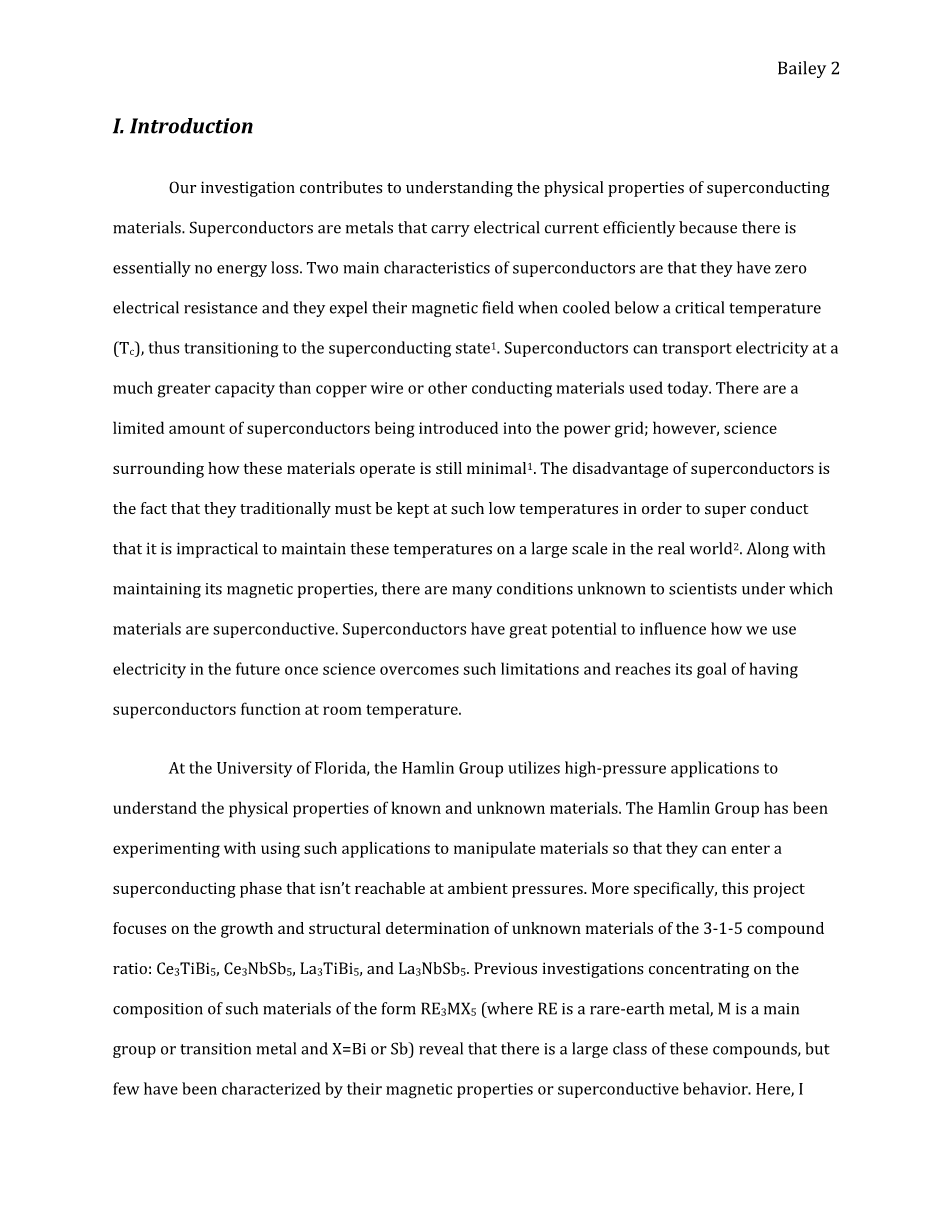本科毕业设计(论文)
外文翻译
Identifying and Investigating Superconductivity in the RE3MX5 Compounds Ce3TiBi5, Ce3NbSb5, La3TiBi5, and La3NbSb5
作者:Taryn Bailey
国籍:The United States
出处:Phys.ufl.edu
Abstract
Single-needled crystal structures of Ce3TiBi5, Ce3NbSb5, La3TiBi5, and La3NbSb5 were grown in a tin flux with the intent to understand the physical properties of these materials and identify them. In terms of this experiment, our focus is on synthesizing these crystals, isolating them, and identifying them through X-ray diffraction and Energy Dispersive X-Ray Spectroscopy (EDS) measurements. If we find an interesting compound has formed, then we can run further tests on its magnetic properties. La3TiBi5 had two different crystal shapes. The needle-shaped crystals exhibit some paramagnetic behavior and are comprised of tin and titanium (Sn5Ti6), according to EDS and X-Ray diffraction analysis. However, the cubic looking crystals in this batch contain La, Bi, and Sn according to EDS. The X-Ray data shows that the crystal is LaSn3 of space group cPm-3m and superconducting at 5.25 K. The EDS measurements for Ce3NbSb5 and La3NbSb5 are very similar, leading to the conclusion that they are both NbSnSb; however, the XRD data does not agree. The crystals have flat four and five-sided faces that extend to a prism shape. The peaks of these crystals in the X-Ray data make it hard to identify these crystals as just NbSbSn, so further tests must be administered. EDS and X-Ray measurements confirm that Ce3TiBi5 crystals are just Sn crystals. Each crystal will need further testing to confirm its identity.
I. Introduction
Our investigation contributes to understanding the physical properties of superconducting materials. Superconductors are metals that carry electrical current efficiently because there is essentially no energy loss. Two main characteristics of superconductors are that they have zero electrical resistance and they expel their magnetic field when cooled below a critical temperature (Tc), thus transitioning to the superconducting state1. Superconductors can transport electricity at a much greater capacity than copper wire or other conducting materials used today. There are a limited amount of superconductors being introduced into the power grid; however, science surrounding how these materials operate is still minimal1. The disadvantage of superconductors is the fact that they traditionally must be kept at such low temperatures in order to super conduct that it is impractical to maintain these temperatures on a large scale in the real world2. Along with maintaining its magnetic properties, there are many conditions unknown to scientists under which materials are superconductive. Superconductors have great potential to influence how we use electricity in the future once science overcomes such limitations and reaches its goal of having superconductors function at room temperature.
At the University of Florida, the Hamlin Group utilizes high-pressure applications to understand the physical properties of known and unknown materials. The Hamlin Group has been experimenting with using such applications to manipulate materials so that they can enter a superconducting phase that isnrsquo;t reachable at ambient pressures. More specifically, this project focuses on the growth and structural determination of unknown materials of the 3-1-5 compound ratio: Ce3TiBi5, Ce3NbSb5, La3TiBi5, and La3NbSb5. Previous investigations concentrating on the composition of such materials of the form RE3MX5 (where RE is a rare-earth metal, M is a main group or transition metal and X=Bi or Sb) reveal that there is a large class of these compounds, but few have been characterized by their magnetic properties or superconductive behavior. Here, I report how we created these crystals and how we will identify them.
In previous work at the Hamlin lab, Ce3TiSb5 was synthesized and exhibited some interesting properties in its magnetization and resistivity, leading us to further investigate the RE3MX5 compounds. Structural unit cell determination can relate outer morphology to inner crystal structure. By knowing this information, we can apply magnetic fields along different axes and determine appropriate orientations to the crystal for examinations. The work surrounding Ce3TiSb5 tells us numerous features in magnetization and lends itself to interesting physics. Figure 1. This is a plot of Magnetization v. Applied Field of both the vertical and horizontal alignment.
Figure 1 shows a meta-magnetic transition. The horizontal orientation has antiferromagnetism when the applied magnetic field is between 0 and 0.5 approximately. At the peak or maximum magnetism the sample becomes ferromagnetic. The interesting properties in this 3-1-5 compound make exploring other 3-1compounds attractive. The following table is a pool ofresearch from labs outside of the University of Florida that conveys what RE3MX5 compounds existand have been studied.
Table 1: Possible 3-1-5 compound combinations
The integration of rare-earth elements into the RE3MX5 crystal structure is a rather new technique. Rare-earth elements are used as stabilizing agents that lower the dimensional features of the crystalrsquo;s layers.3 Similarly, ternary rare-earth antimonides may possess properties that are expected to be dimensionally unbalanced along different axes, but may also exhibit metallic or semi-metallic behavior3. Since
剩余内容已隐藏,支付完成后下载完整资料


英语原文共 18 页,剩余内容已隐藏,支付完成后下载完整资料
资料编号:[276654],资料为PDF文档或Word文档,PDF文档可免费转换为Word
以上是毕业论文外文翻译,课题毕业论文、任务书、文献综述、开题报告、程序设计、图纸设计等资料可联系客服协助查找。


